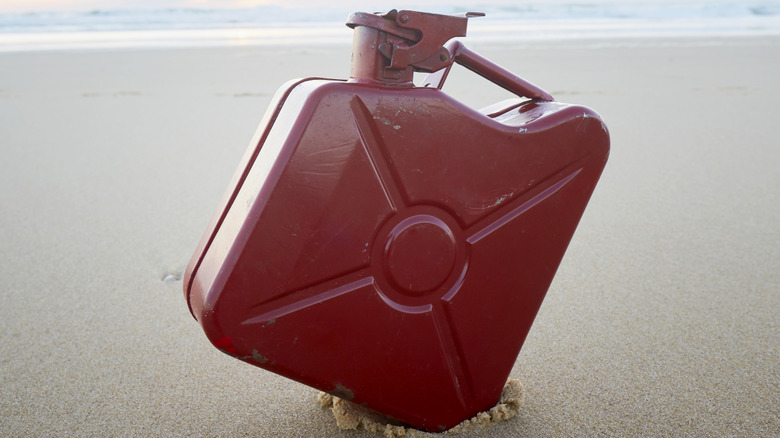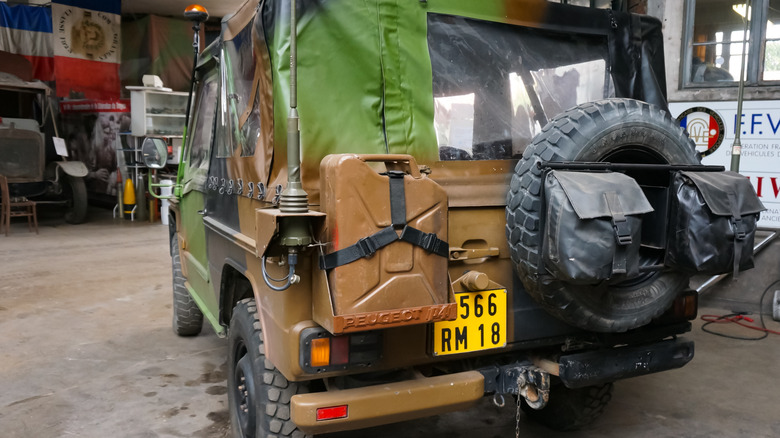How To Safely Store A Gasoline Jerry Can While Off-Roading
Off-roading comes with its own unique set of challenges. Off-road vehicles and their intrepid drivers routinely face hazards above and beyond those encountered in the urban commute. This can include crawling a vehicle over rocks, across rivers, through dense scrub, and over terrain ranging from dusty and bumpy trails to sandy beaches and deserts — even rolling over smoldering fire grounds. Adventurous, off-roading areas can be many miles from the nearest gas station, so a couple of jerry cans or more of extra fuel are likely to be essential cargo.
Gasoline is a volatile fuel that is explosive in the presence of air, so how do we safely store a jerry can of gas while off-roading? The answer lies in following the same principles as storing a lead-acid battery, which also emits an explosive gas — hydrogen — when under charge. Both jerry cans and car batteries should be secured upright, in a well-ventilated area outside the passenger cab, away from potential impact zones of or sources of ignition. If the gasoline is to be stored unused for a long time, add a stabilizer from an automotive or hardware store.
Fuel tanks on modern cars have devices like Evaporative Emission Control (EVAP) and even capless filler systems to keep vapors under control, but such safety features are not present when loading five-gallon cans of gas onto your rig. Any hazards will increase proportional to the length and difficulty your off-road journey, so it is critical to store jerry cans properly.
Keep your cans sealed, secure, and away from flame
Regardless of whether your prefer overlanding in an SUV or a pickup truck, it is never a good idea to fill or store a jerry can inside your vehicle, as the fumes can adversely affect the occupants. To fill a can, place it on the ground and touch the nozzle of the pump to the can before filling, to discharge any static electricity.
If you must carry a jerry can inside your cabin, ensure it is properly sealed and secured upright within a well-ventilated area, with no smoking, sparks, or naked flame — and keep the trip short. Think twice before storing jerry cans in the trunk, or any enclosed area, as gasoline vapor in a confined space creates the risk of explosion. Even "empty" gas cans contain dangerous vapors.
The best place to safely store your jerry cans is secured to a purpose-built storage rack at the rear of your vehicle, or inside the open tray of a pickup. Such holders are available from suppliers of aftermarket off-road equipment. Manufacturers like Maxtrax, RotopaX and AEV also make polypropylene containers that can be secured to the side of your vehicle or around the spare wheel. Some off-road experts say jerry cans should be stored low and close to the center of the vehicle, others argue they can go on the roof. Keep in mind a low centre of gravity will help prevent vehicle rollover and reduces the risks posed by lifting a 30-pound drum of fuel over your head.
The steel jerry can's military-grade design
Gasoline has a lower flash point than diesel, but diesel fumes are also flammable and have their own risks. Whether carrying gas or diesel, jerry cans are best stored out of direct sunlight and away from sources of heat like camp fires and stoves. While the classic, five-gallon, steel jerry can is sturdy and resistant to leaks, the risk of rupture is increased by overfilling. Never fill cans to the brim by "topping off" or tilting the can back to fill the space behind the handle, as that air pocket is there for a purpose. Not only does it allow for thermal expansion of the fuel, but that small air gap means the can will float if accidentally dropped into water.
While "jerry can" may refer to different types of fuel containers, the original dates back to an ingeniously designed steel container used by German forces during World War II. The Allies, particularly the British, referred to German opposition forces as "the jerry", and the name has stuck to this three-handled, pressed steel design, with its clamp-down, retractable lid. The triple handle means two cans can be carried side-by-side in one hand, and easily be passed from one person to another, bucket-brigade style, to allow quick loading. While the classic jerry can is well designed, it is worth periodically checking the rubber seal around the spout, as these can harden or perish. The seals are inexpensive, and available at automotive or hardware stores.


